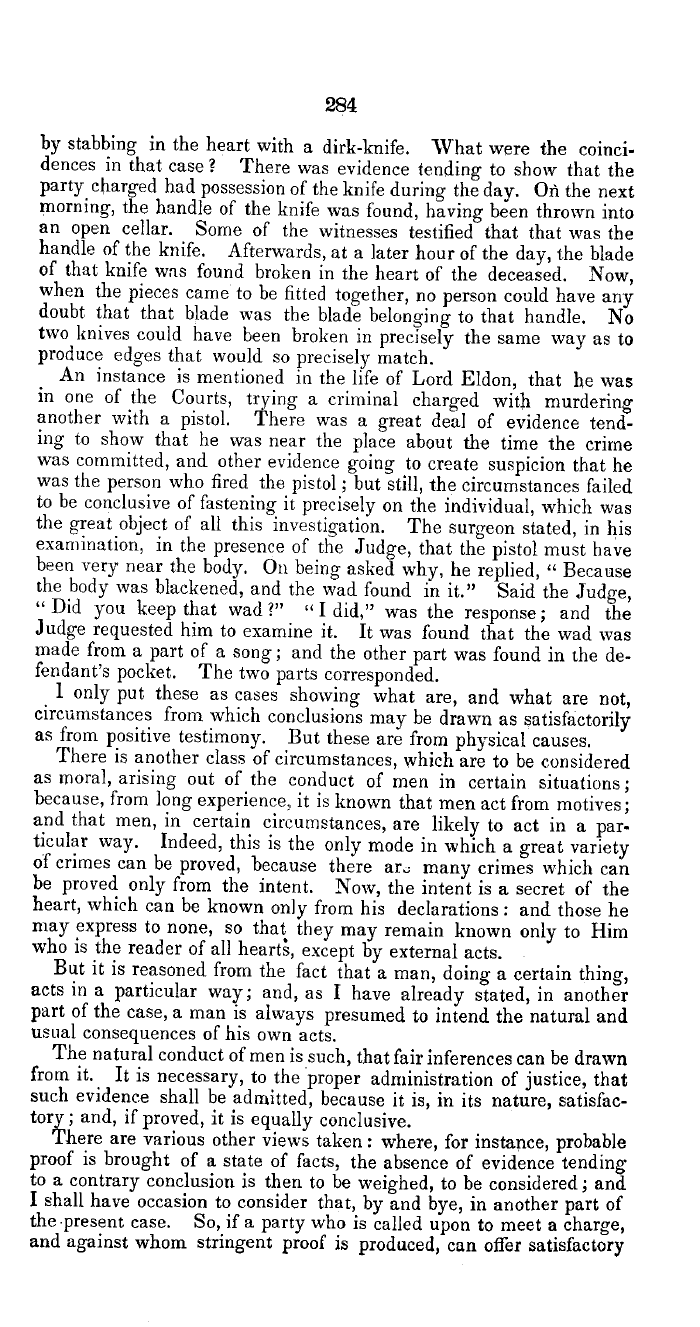|
284
by stabbing in the heart with a dirk-knife. What were the coinci-
dences in that case? There was evidence tending to show that the
party charged had possession of the knife during the day. On the next
morning, the handle of the knife was found, having been thrown into
an open cellar. Some of the witnesses testified that that was the
handle of the knife. Afterwards, at a later hour of the day, the blade
of that knife was found broken in the heart of the deceased. Now,
when the pieces came to be fitted together, no person could have any
doubt that that blade was the blade belonging to that handle. No
two knives could have been broken in precisely the same way as to
produce edges that would so precisely match.
An instance is mentioned in the life of Lord Eldon, that he was
in one of the Courts, trying a criminal charged with murdering
another with a pistol. There was a great deal of evidence tend-
ing to show that he was near the place about the time the crime
was committed, and other evidence going to create suspicion that he
was the person who fired the pistol ; but still, the circumstances failed
to be conclusive of fastening it precisely on the individual, which was
the great object of all this investigation. The surgeon stated, in his
examination, in the presence of the Judge, that the pistol must have
been very near the body. On being asked why, he replied, °1 Because
the body was blackened, and the wad found in it." Said the Judge,
11 Did you keep that wad?" « I did," was the response; and the
Judge requested him to examine it. It was found that the wad was
made from a part of a song; and the other part was found in the de-
fendant's pocket. The two parts corresponded.
I only put these as cases showing what are, and what are not,
circumstances from which conclusions may be drawn as satisfactorily
as from positive testimony. But these are from physical causes.
There is another class of circumstances, which are to be considered
as moral, arising out of the conduct of men in certain situations;
because, from long experience, it is known that men act from motives;
and that men, in certain circumstances, are likely to act in a par-
ticular way. Indeed, this is the only mode in which a great variety
of crimes can be proved, because there ar,; many crimes which can
be proved only from the intent. Now, the intent is a secret of the
heart, which can be known only from his declarations : and those he
may express to none, so that they may remain known only to Him
who is the reader of all hearts, except by external acts.
But it is reasoned from the fact that a man, doing a certain thing,
acts in a particular way; and, as I have already stated, in another
part of the case, a man is always presumed to intend the natural and
usual consequences of his own acts.
The natural conduct of men is such, that fair inferences can be drawn
from it. It is necessary, to the proper administration of justice, that
such evidence shall be admitted, because it is, in its nature, satisfac-
tory ; and, if proved, it is equally conclusive.
There are various other views taken: where, for instance, probable
proof is brought of a state of facts, the absence of evidence tending
to a contrary conclusion is then to be weighed, to be considered; and
I shall have occasion to consider that, by and bye, in another part of
the present case. So, if a party who is called upon to meet a charge,
and against whom stringent proof is produced, can offer satisfactory
|

